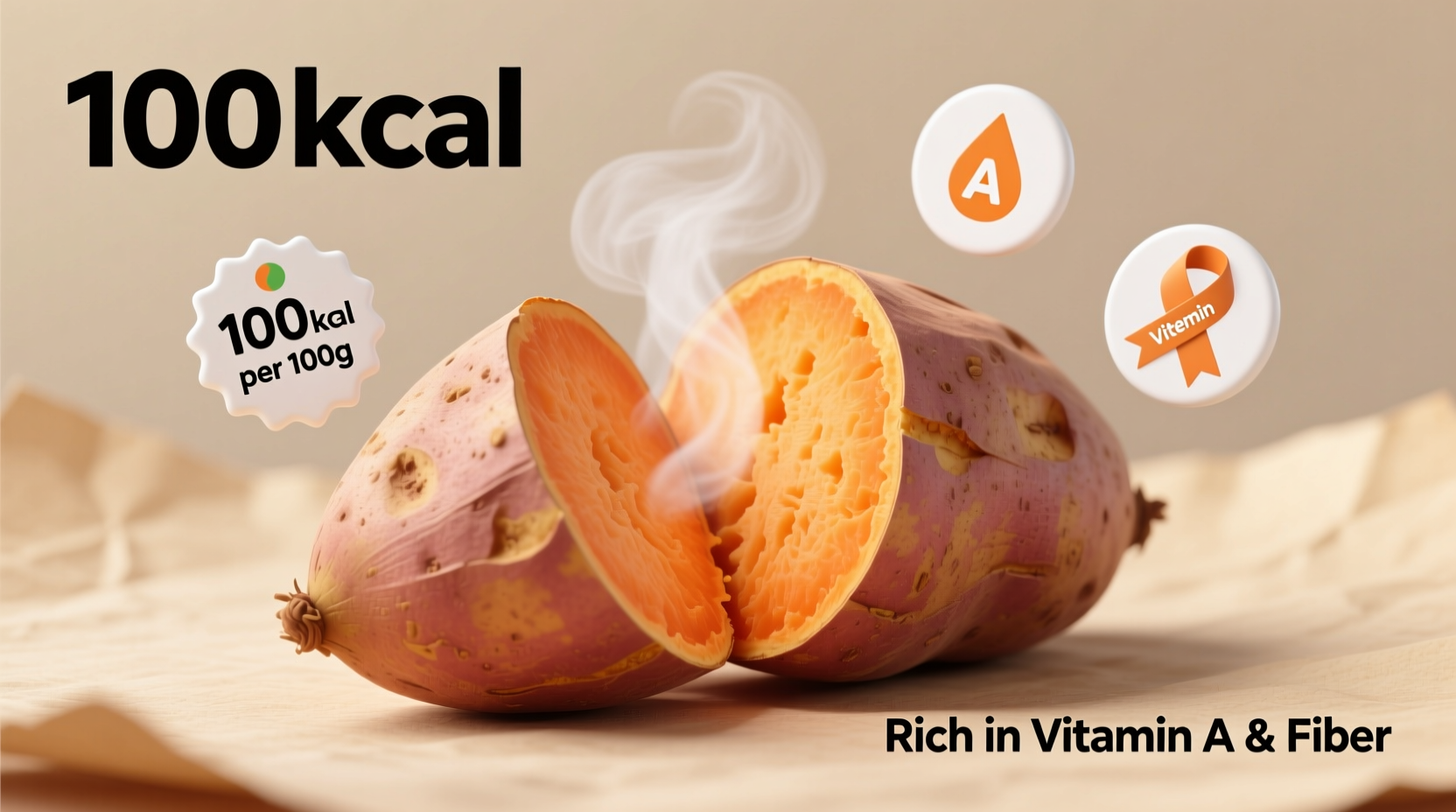Understanding the precise calorie content of sweet potatoes helps you make informed dietary choices without sacrificing flavor or nutrition. Whether you're tracking macros, managing weight, or simply curious about this versatile vegetable, knowing exactly what you're consuming matters.
How Cooking Method Changes Sweet Potato Calories
The way you prepare sweet potatoes significantly impacts their calorie density. While the vegetable itself remains nutritionally consistent, added ingredients and water content during cooking alter the final count. Here's how different preparation methods affect calories per 100g serving:
| Cooking Method | Calories per 100g | Key Changes |
|---|---|---|
| Raw | 86 | Maximum nutrient retention, slightly harder to digest |
| Baked with skin | 90 | Concentrates natural sugars, highest vitamin A availability |
| Boiled | 76 | Some water-soluble nutrients leach into cooking water |
| Steamed | 82 | Balances nutrient retention and texture |
| Homemade fries (baked) | 130 | Additional oil increases calories but maintains fiber |
| Deep-fried | 165 | Significantly higher fat content, reduced nutritional value |
This data comes from the USDA FoodData Central database, the most authoritative source for nutritional information in the United States (fdc.nal.usda.gov). Notice how boiling actually reduces calorie density through water absorption, while frying dramatically increases it through oil absorption.
Sweet Potato Size Matters: Calorie Counts by Portion
When tracking calories, portion size is critical. Sweet potatoes vary dramatically in size, making "per potato" counts more practical than standard measurements:
- Small (80g): 68 calories - perfect for snack portions
- Medium (130g): 103 calories - standard single serving size
- Large (180g): 151 calories - common restaurant portion
- Jumbo (270g+): 228+ calories - often seen in grocery stores
According to agricultural research from the International Potato Center (www.cipotato.org), sweet potato sizes have increased by approximately 25% over the past two decades due to selective breeding for commercial production. This means older calorie charts may significantly underestimate current serving sizes.

Nutritional Benefits Beyond Calories
While calorie count matters, sweet potatoes offer exceptional nutritional value per calorie. A medium baked sweet potato delivers:
- Vitamin A: 438% of daily value from beta-carotene (supports vision and immunity)
- Vitamin C: 37% of daily value (boosts collagen production and antioxidant protection)
- Dietary Fiber: 15% of daily value (promotes gut health and satiety)
- Potassium: 10% of daily value (regulates blood pressure)
- Manganese: 28% of daily value (supports bone health and metabolism)
Research published in the American Journal of Clinical Nutrition confirms that the complex carbohydrates in sweet potatoes provide sustained energy release, with a glycemic index of 44-50 depending on preparation method - significantly lower than white potatoes (GI 70-85).
Sweet Potato vs Regular Potato: Nutritional Comparison
Many people wonder whether sweet potatoes are truly healthier than regular potatoes. Here's how they compare nutritionally per 100g:
- Vitamin A: Sweet potatoes contain 709 μg RAE; regular potatoes have virtually none
- Vitamin C: Sweet potatoes: 21.3 mg; regular potatoes: 19.7 mg
- Fiber: Sweet potatoes: 3 g; regular potatoes: 2.2 g
- Glycemic Index: Sweet potatoes: 44-50; regular potatoes: 70-85
- Antioxidants: Sweet potatoes contain higher levels of anthocyanins and beta-carotene
The Centers for Disease Control and Prevention recognizes sweet potatoes as a "superfood" due to their exceptional nutrient density (cdc.gov/healthyweight). However, both types of potatoes can be part of a healthy diet when prepared properly.
Practical Meal Planning with Sweet Potatoes
Incorporating sweet potatoes into your diet requires understanding their role in your overall nutrition goals. Here's how to use them effectively:
For weight management: A medium sweet potato (103 calories) makes an excellent carbohydrate source that keeps you full longer than refined carbs. Pair with lean protein and non-starchy vegetables for balanced meals.
For athletic performance: Consume baked sweet potatoes 2-3 hours before endurance activities for sustained energy release. The complex carbohydrates provide steady fuel without blood sugar spikes.
For blood sugar control: Always eat sweet potatoes with a source of healthy fat (like olive oil or avocado) and protein to slow glucose absorption. Cooling cooked sweet potatoes increases resistant starch content by up to 30%, further reducing glycemic impact.
Common Misconceptions About Sweet Potato Calories
Several myths persist about sweet potato nutrition that deserve clarification:
- "Sweet potatoes are too high in sugar for diabetics": While naturally sweet, their fiber content and lower glycemic index make them suitable for most diabetes management plans when portion-controlled.
- "The skin contains most calories": The skin actually contains additional fiber and nutrients with minimal calorie contribution - always eat with skin for maximum benefit.
- "All orange-fleshed varieties have identical nutrition": Different cultivars vary significantly in nutrient density - Jewel and Garnet varieties typically have higher beta-carotene content than Hannah or Japanese varieties.
According to agricultural studies from Louisiana State University Agricultural Center, the orange-fleshed varieties we commonly eat today represent just one type of sweet potato. Purple-fleshed varieties, increasingly available in markets, contain different antioxidant profiles with comparable calorie counts but distinct health benefits.
Maximizing Nutritional Value: Preparation Tips
To get the most nutritional benefit from sweet potatoes while managing calories:
- Don't peel before cooking: The skin contains valuable fiber and nutrients - simply scrub thoroughly
- Pair with healthy fats: Add 1 tsp of olive oil to enhance absorption of fat-soluble vitamins
- Cool before eating: Let cooked sweet potatoes cool to increase resistant starch content
- Avoid sugary toppings: Skip marshmallows and brown sugar - try cinnamon or herbs instead
- Use the cooking water: When boiling, use the nutrient-rich water in soups or sauces
These preparation methods help maintain the exceptional nutrient-to-calorie ratio that makes sweet potatoes a nutritional powerhouse. Remember that how you prepare sweet potatoes matters more than the vegetable itself when managing calorie intake.











 浙公网安备
33010002000092号
浙公网安备
33010002000092号 浙B2-20120091-4
浙B2-20120091-4